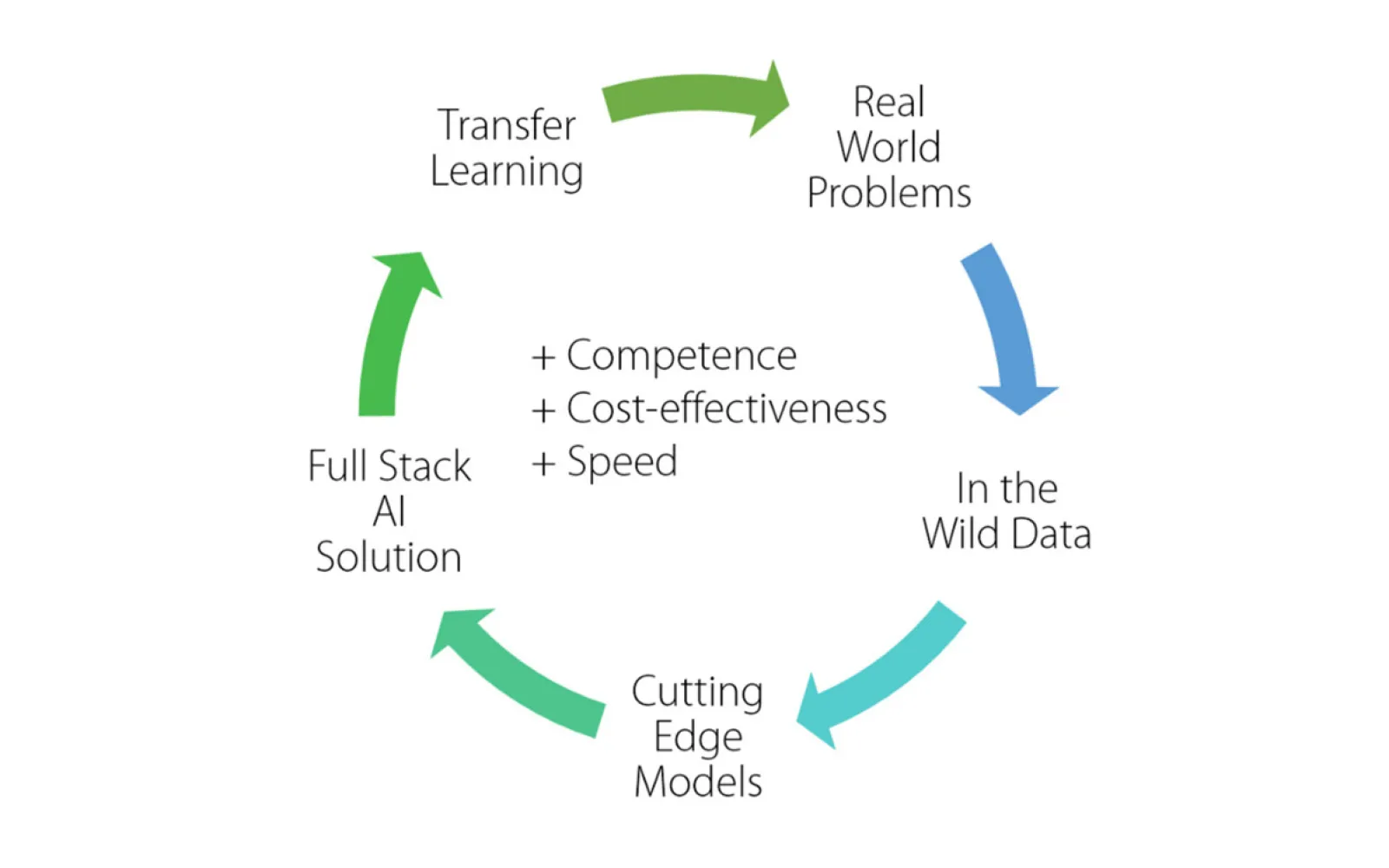
DCVC’s Investment in Element AI: Realizing the Promise of AI for Every Company and Government

Bring AI Down from Olympus
In New York City’s Rockefeller Center plaza, there stands a sculpture of Prometheus, the Titan whom Greek mythology credits with stealing fire from the jealous clutches of the Olympian gods and bringing its transformational benefits to humankind.
This theme of powerful forces that deny their unique advantage to large numbers of other people is recurrent in human history — especially in economics. One of the best parts about venture capital, practiced right, is that you can empower a Prometheus to remedy this kind of imbalance, make a lot of people happy, and make money at the same time.
Digital Equipment Corp. (DEC), Data General (DG), and ultimately companies like Apple unlocked computer ownership for geometrically larger audiences — and flourished as a result. Intel and Microsoft liberated software creation from the old mainframe gods, ignited a multi-decade explosion of software innovation, and became giants themselves. NVIDIA transformed science and engineering by liberating supercomputing capabilities from the glass house, bringing them to the desktop and beyond — and is now a giant in its own right.
Today, it is AI — not just deep learning and neural network technology, but the entire suite of machine learning expertise called AI — that is available in economically usable form to only the largest tech companies or the top of the Fortune 500, who can pay to “lease expertise.”
The AI expertise to solve customer-specific problems in product reliability and uptime, energy efficiency, optimizing supply chains, mining knowledge for insight, accelerating product innovation, improving cybersecurity, scoring and managing financial and operational risk remains the province of large, very expensive teams.
And, most of these teams are locked up in their own specific Olympus, crafting academic papers that are hard to transform into “in-line”, field-ready solutions without an elite, expensive team already on staff. For the Fortune “4950,” and all but the world’s largest and richest governments, it’s a fearful Catch-22.
The most serious problems facing global industry and government today involve too much complex and rapidly changing data for the cognitive capacity of even large numbers of human experts working together. These groups — and the customers and citizens they serve — need intelligent systems that can work in concert with them to field that scale and complexity. These companies and governments also need solutions more cost-effectively and more quickly than any vendor could previously provide.
DCVC led Element AI’s record $102 million Series A, with our friends from Intel, NVIDIA, and Microsoft, and other leading global institutions, because . Element AI and their team of world-class researchers and engineers can
• solve these nearly impossible problems;
• do so more quickly and cost-effectively than anyone else; and,
• do so with a non-predatory model that democratizes the power of AI, worldwide.
The Element AI Virtuous Cycle: Delivering High-Impact AI Solutions for Real Customers Faster and Less Expensively

Element AI is not a consultancy like Accenture, or IBM Global Services, which generally make more money the more bodies they throw at a customer’s problem. Element AI uses a suite of AI software, constantly being improved by its 100 person team of elite researchers (soon to exceed 250), and augmented by its large cooperative academic network, to empower its customers with a model far more like enterprise software.
To empower its customers, Element AI:
• applies its unique capabilities to help its customers process and cleanse their large proprietary data sets;
• applies GAN and similar models where necessary to enrich and increase data for training and analysis; and,
• employs its tool set to rapidly train, validate, and improve full stack AI solutions that can run “in line” with real-world processes.
For example, Element AI’s software solutions can control rugged industrial systems in factories and in the field in real time, detect fraud or cyberattacks within financial systems as transactions happen, and solve logistics problems even as resources are on the move.
Once Element AI has solved a problem for a given domain, it can apply the knowledge (but never customer proprietary data) to a new domain using the AI technique of “transfer learning”. This reduces both Element AI’s and its customers’ costs and time to a solution with every new customer.
Consider the problem of a giant HVAC system on the roof of a large building. As it begins to fail, it becomes less energy efficient, and it also results in huge costs for the manufacturer/service company (and the building owner) with an unexpected failure. An AI system that can predict and detect these failures well before humans, avoiding energy costs and unpredictable service costs, is meaningful to both the building owner and the HVAC manufacturer.
In Element AI’s case, having solved this problem for a giant HVAC system — a complex machine with a big spinning blade, temperature extremes of heat and cold, large amounts of electricity in and out, hydraulics and pneumatics — they can use transfer learning to model something surprisingly similar… a jet engine.
This “virtuous spiral” of competence, cost-effectiveness, and speed — across remarkably different industrial and business domains — is great for both Element AI and its customers. And, when a solution is truly disruptive and broadly applicable, it creates an opportunity for Element AI and the customer to jointly develop it into a stand-alone business, as General Electric has with its “Predix” group.
A Non-Predatory, Cooperative Model With Academia Creates the World’s Largest Force in AI

Some large corporations march into a local AI ecosystem and “clear cut” the AI resources of its universities’ computer science departments, luring away with exorbitant salaries not just critical Professors but also their post-docs and PhD students, leaving universities ill-equipped to push AI forward. Publishing a handful of papers from behind the walls of Olympus doesn’t really make up for this predation in the eyes of universities and their host cities, states, and countries — they’ve essentially been robbed of the benefit of hundreds of millions of dollars in academic investment and decades of department building.
Element AI, by contrast, created a non-predatory, cooperative model with leading academic institutions, driven by Element’s co-founder, Dr. Yoshua Bengio of the University of Montreal. Yoshua, widely considered to be one of the three founders of modern AI, built a multi-hundred person renowned AI institute at University of Montreal, called MILA, and he wanted to see its innovations thrive commercially without his academic labor of decades somehow compromised.
Together with Element co-founder Jean François Gagne, Yoshua developed a model of visiting “fellows” for academics to work with Element. This model enables world-class professors and even several of their top students to come to Element AI, get paid as if they were in private industry, work on world-changing problems, and still publish (respecting Element’s and its clients’ proprietary rights) groundbreaking papers — all without surrendering their position or having to destroy their department or lab.
With this model, Element AI embraces the top researchers from the leading schools and institutes in Canada — University of Montreal, MILA, McGill, University of Toronto, University of Waterloo, University of British Columbia, and University of Calgary, to name a few — and many more worldwide.
By pursuing a cooperative, non-predatory model for AI talent, Element AI enjoys an aggregate footprint between its team and academic relationships that at least matches if not exceeds those fielded by the largest technology companies in the world.
A Commitment to Canada — and Montreal aura son beau jour au soleil!

With this investment, DCVC continues its role as one of the leading Silicon Valley backers of Canadian-centric deep-tech companies. We plan on continuing to do so for many years to come, as we noted to the Wall Street Journal a few months back, because of Canada’s under-appreciated prowess in deep tech, friendly immigration policies, and excellent universities.
At the same time, we are happy to support Yoshua and Jean François and their team at Element AI, and our great co-investor JS Cournoyer of Real Ventures, in their commitment to build a multi-billion-dollar, sustainable public company that anchors decades of deep tech innovation in Montreal, in Quebec, and in Canada at large.
We at DCVC understand that Montreal has had global tech leadership with a flagship company several times, from Matrox to Softimage, only to see it recede. We believe that Element AI and its team will help Montreal to “have its bright day in the sun” once again in tech leadership.
Renewable Resource: A Sustainable AI Startup Ecosystem that Mines AI Models Instead of Diamonds

We believe that Element AI, in every Canadian city and with every University that it touches, with every Canadian client it takes on, has the opportunity to help generate new AI-centric startups, and new deep tech startups (e.g., robotics) in general. At DCVC, we feel that Element AI is creating an endlessly renewable “natural resource” for Canada by concentrating, training and professionalizing elite AI talent throughout Canada, and with this talent building AI models that deliver life-and-death actionable insight to governments and corporations. We believe these resources are worth more than diamonds, but never run out.
Thanks to James Hardiman and Jean Xin.
Related Companies

Related Content

Davos 2024: A decisive moment for DCVC’s deep tech investment thesis

DCVC companies are at the forefront of better generative AI: Databricks to acquire MosaicML for $1.3B

Element AI raises $151M Series B to enable artificial intelligence at the heart of every company
